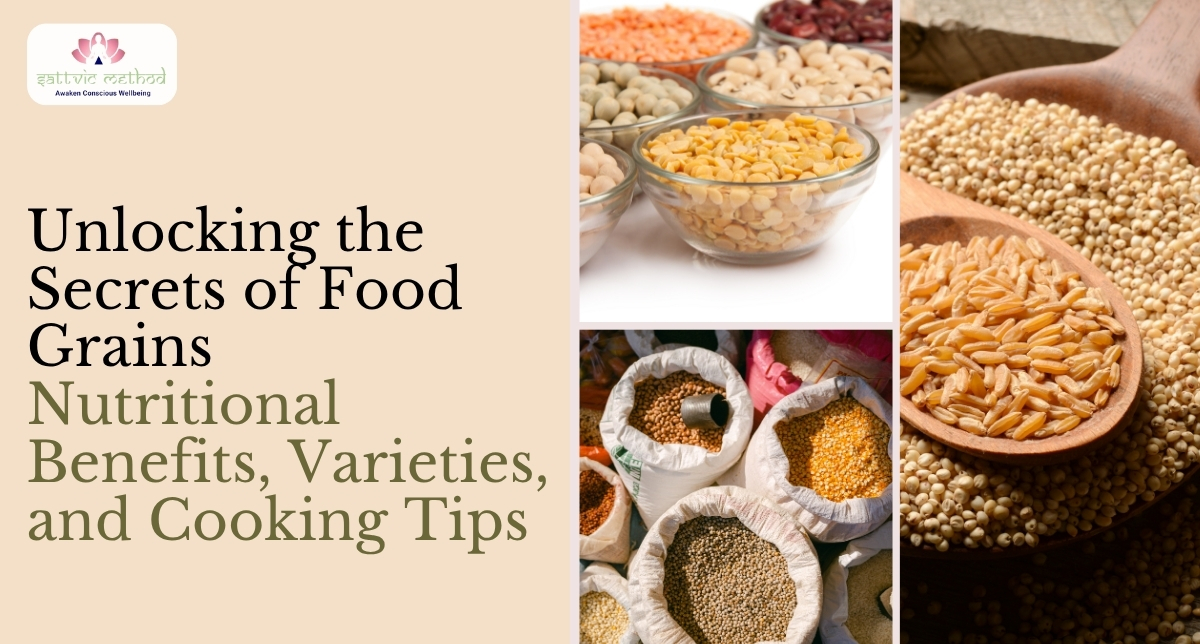Unlocking the Secrets of Food Grains: Nutritional Benefits, Varieties, and Cooking Tips
Food grains are the unsung heroes of our diets, brimming with nutritional benefits and versatility. From the nutty aroma of quinoa to the comforting familiarity of rice, these pantry staples offer not only sustenance but also a wealth of flavors and textures. In a world where nutritional choices can be overwhelming, understanding the varieties of food grains and mastering the art of cooking them can elevate your meals to new heights. In this article, we will explore the secrets behind popular grains, unveil their health benefits, and share invaluable cooking tips that will transform how you approach these essential ingredients. Join us on this culinary adventure and discover how food grains can enhance your diet, inspire your cooking, and support your journey toward healthier living. Whether you’re a novice in the kitchen or a seasoned chef, there’s something here for everyone to savor and enjoy.
Nutritional Benefits of Food Grains
Food grains are nutritional powerhouses, packed with essential vitamins, minerals, and fiber. They offer a rich source of carbohydrates, the body’s primary energy source, ensuring that you stay energized throughout your day. Additionally, grains are loaded with B vitamins, such as niacin, thiamine, and riboflavin, which play crucial roles in metabolic processes and brain function. Including a variety of grains in your diet can help meet your daily nutrient requirements and support overall health.
One of the most significant advantages of consuming food grains is their high fiber content. Dietary fiber aids in digestion, helps maintain healthy bowel movements, and can prevent constipation. Moreover, fiber has been linked to lower cholesterol levels, reduced blood pressure, and a decreased risk of heart disease. By incorporating whole grains into your meals, you can also enjoy better blood sugar control, making them a beneficial choice for individuals with diabetes or those looking to manage their weight.
In addition to vitamins and fiber, food grains are excellent sources of essential minerals like iron, magnesium, and selenium. Iron is vital for transporting oxygen throughout the body and preventing anemia, while magnesium supports muscle and nerve function, as well as bone health. Selenium acts as an antioxidant, protecting cells from damage and boosting the immune system. With such a diverse array of nutrients, food grains are an indispensable component of a balanced diet, contributing to both short-term and long-term health benefits.
Common Varieties of Food Grains
The world of food grains is vast and varied, offering a plethora of options to suit different culinary preferences and dietary needs. Some of the most common varieties include rice, wheat, oats, barley, quinoa, millet, and rye. Each grain has its unique flavor, texture, and nutritional profile, making it easy to find the perfect match for any meal.
Rice is a staple food for more than half of the world’s population, with numerous varieties such as basmati, jasmine, brown, and wild rice. Wheat, another global staple, is the primary ingredient in bread, pasta, and many other baked goods. Oats are well-known for their heart-healthy properties and are often enjoyed as a warm breakfast cereal or used in baking. Barley, with its chewy texture and nutty flavor, is a versatile grain that can be used in soups, stews, and salads.
Quinoa, often referred to as a superfood, is a complete protein, meaning it contains all nine essential amino acids. This makes it an excellent choice for vegetarians and vegans. Millet and rye are less commonly used but offer unique flavors and nutritional benefits. Millet is a gluten-free grain that can be used in a variety of dishes, while rye is often found in hearty breads and has a distinctive, slightly tangy taste. Exploring these different grains can add excitement and variety to your meals, while also providing a range of health benefits.
Whole Grains vs. Refined Grains
When it comes to choosing between whole grains and refined grains, whole grains are generally the healthier option. Whole grains consist of the entire grain kernel, including the bran, germ, and endosperm. This means they retain more nutrients and fiber compared to refined grains, which have been processed to remove the bran and germ, leaving only the starchy endosperm.
The refining process strips away many of the essential vitamins, minerals, and fiber found in whole grains. As a result, refined grains have a higher glycemic index, which can lead to rapid spikes in blood sugar levels. Consuming whole grains, on the other hand, provides a slower and more sustained release of energy, helping to keep blood sugar levels stable and reducing the risk of developing type 2 diabetes.
Incorporating whole grains into your diet is relatively simple and can be done by making small swaps in your daily meals. Choose whole grain bread, pasta, and cereals instead of their refined counterparts. Experiment with grains like brown rice, quinoa, and barley in place of white rice or other refined grains. By prioritizing whole grains, you can enjoy their numerous health benefits and support your overall well-being.
Cooking Techniques for Different Grains
Mastering the art of cooking food grains can elevate your culinary skills and enhance the flavors of your dishes. Different grains require varying cooking techniques and times to achieve the perfect texture and taste. Understanding these methods can help you create delicious and nutritious meals with ease.
Rice, for instance, can be cooked using several methods, including boiling, steaming, and absorption. The absorption method involves cooking rice in a measured amount of water until all the liquid is absorbed. This technique works well for long-grain varieties like basmati and jasmine rice. For brown rice, which takes longer to cook, you may need to use more water and increase the cooking time. Quinoa, on the other hand, requires rinsing before cooking to remove its natural coating, which can taste bitter. It is then cooked in a 2:1 water-to-quinoa ratio until the grains are tender and the water is absorbed.
Oats can be prepared in various ways, depending on the type. Rolled oats are commonly used for oatmeal and require simmering in water or milk until they reach a creamy consistency. Steel-cut oats, which are less processed, take longer to cook but offer a chewier texture and nuttier flavor. Barley can be cooked similarly to rice, with a 3:1 water-to-barley ratio, and is best when simmered until tender. Experimenting with different cooking techniques and grains can help you discover new flavors and textures, making your meals more enjoyable and nutritious.
Incorporating Grains into Your Diet
Incorporating a variety of grains into your diet can be both simple and rewarding. Start by making small changes to your daily meals, such as swapping white bread for whole grain bread or using quinoa instead of rice. These minor adjustments can have a significant impact on your overall health and well-being.
Breakfast is an excellent opportunity to include grains in your diet. Enjoy a bowl of oatmeal topped with fresh fruit and nuts, or try a quinoa breakfast bowl with yogurt and berries. Whole grain cereals and granola can also be nutritious options to start your day. For lunch and dinner, consider adding grains to salads, soups, and stews. A hearty barley soup or a quinoa-stuffed bell pepper can provide a satisfying and nutrient-dense meal.
Snacks and desserts can also benefit from the addition of grains. Whole grain crackers with hummus, homemade granola bars, or oat-based cookies can be healthier alternatives to traditional snacks. By incorporating a variety of grains into your diet, you can ensure that you receive the essential nutrients needed for optimal health while enjoying diverse and delicious meals.
Health Benefits of Specific Grains
Each type of grain offers unique health benefits, making them valuable additions to your diet. Quinoa, for example, is a complete protein, providing all nine essential amino acids. This makes it an excellent choice for vegetarians and vegans looking to meet their protein needs. Additionally, quinoa is rich in fiber, magnesium, and antioxidants, which can help reduce inflammation and support overall health.
Oats are well-known for their heart-healthy properties, thanks to their high beta-glucan content. Beta-glucan is a type of soluble fiber that has been shown to lower cholesterol levels and improve heart health. Oats also have a low glycemic index, making them a suitable option for individuals with diabetes or those looking to manage their blood sugar levels. Furthermore, oats contain a variety of vitamins and minerals, including manganese, phosphorus, and magnesium.
Barley is another grain with impressive health benefits. It is high in fiber, particularly beta-glucan, which can help lower cholesterol and improve digestion. Barley is also a good source of vitamins and minerals, such as selenium, copper, and manganese. Its anti-inflammatory properties can support overall health and reduce the risk of chronic diseases. By including a variety of grains in your diet, you can enjoy their unique health benefits and support your overall well-being.
Popular Grain-Based Recipes
Exploring grain-based recipes can add variety and excitement to your meals while ensuring you receive the numerous health benefits of these nutritious ingredients. One popular recipe is a quinoa salad, which combines cooked quinoa with fresh vegetables, herbs, and a light vinaigrette. This versatile dish can be customized with your favorite ingredients, such as cherry tomatoes, cucumbers, and feta cheese, making it a perfect option for a light lunch or side dish.
For a hearty and comforting meal, try making a barley and vegetable soup. This dish features tender barley, a medley of vegetables, and flavorful broth, creating a satisfying and nutritious meal. You can also experiment with different grains in your baking, such as using whole wheat flour in place of white flour in bread and muffins. Whole grain pancakes or waffles can be a delicious and healthy breakfast option, especially when topped with fresh fruit and a drizzle of maple syrup.
Another popular grain-based recipe is a rice and bean bowl, which combines cooked rice, black beans, corn, avocado, and salsa for a delicious and nutrient-dense meal. This dish can be customized with your favorite toppings, such as shredded cheese, sour cream, or chopped cilantro. By experimenting with different grain-based recipes, you can discover new flavors and textures while enjoying the numerous health benefits of these versatile ingredients.
Myths and Facts About Food Grains
There are many myths and misconceptions surrounding food grains, which can make it challenging to make informed dietary choices. One common myth is that all grains are bad for you and should be avoided. However, this is not true. Whole grains, in particular, offer numerous health benefits, including improved digestion, heart health, and blood sugar control. It is essential to distinguish between whole grains and refined grains when making dietary decisions.
Another myth is that grains are fattening and should be eliminated from weight loss diets. While it is true that consuming large quantities of refined grains can contribute to weight gain, whole grains can actually support weight management. The high fiber content in whole grains helps you feel fuller for longer, reducing the likelihood of overeating. Additionally, whole grains have a lower glycemic index, which can help stabilize blood sugar levels and prevent cravings.
Some people believe that grains are not suitable for individuals with gluten intolerance or celiac disease. While it is true that certain grains, such as wheat, barley, and rye, contain gluten, there are many gluten-free grain options available. Quinoa, rice, millet, and buckwheat are all naturally gluten-free and can be safely consumed by those with gluten sensitivities. By understanding the facts about food grains, you can make informed choices and enjoy their numerous health benefits.
Conclusion: Embracing Grains for a Healthier Lifestyle
Incorporating a variety of food grains into your diet can significantly enhance your overall health and well-being. These nutritional powerhouses provide essential vitamins, minerals, and fiber, supporting everything from digestion to heart health. By choosing whole grains over refined grains, you can enjoy a slower release of energy, better blood sugar control, and a reduced risk of chronic diseases.
Exploring the different varieties of grains and mastering their cooking techniques can add excitement and diversity to your meals. From the nutty flavor of quinoa to the chewy texture of barley, there is a grain to suit every palate and dietary preference. By experimenting with grain-based recipes, you can discover new flavors and textures while reaping the numerous health benefits of these versatile ingredients.
Ultimately, embracing grains as a staple in your diet can support your journey toward healthier living. Whether you are a novice in the kitchen or a seasoned chef, there is always something new to learn and enjoy. By making informed choices and incorporating a variety of grains into your meals, you can enhance your diet, inspire your cooking, and support your overall well-being. So, embark on this culinary adventure and unlock the secrets of food grains for a healthier and more delicious lifestyle.




